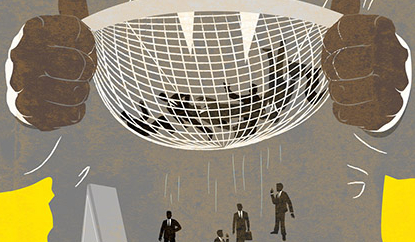英文法律词典 I-75
|
ISSUE, pleading. An issue, in pleading, is defined to be a single, certain and material point issuing out of the allegations of the parties, and consisting, regularly, of an affirmative and negative. In common parlance, issue also signifies the entry of the pleadings. 1 Chit. Pl. 630. 2. Issues are material when properly formed on some material point, which will decide the question in dispute between the parties; and immaterial, when formed on some immaterial fact, which though found by the verdict will not determine the merits of the cause, and would leave the court at a loss how to give judgment. 2 Saund. 319, n. 6. 3. Issues are also divided into issues in law and issues in fact. 1. An issue in law admits all the facts and rests simply upon a question of, law. It is said to consist of a single point, but by this it must be understood that such issue involves, necessarily, only a single rule or principle of law, or that it brings into question the legal sufficiency of a single fact only. It is meant that such an issue reduces the whole controversy to the single question, whether the facts confessed by the issue are sufficient in law to maintain the action or defence of the party who alleged them. 2. An issue in fact, is one in which the parties disagree as to their existence, one affirming they exist, and the other denying it. By the common law, every issue in fact, subject to some exceptions, which are noticed below, must consist of a direct affirmative allegation on the one side, and of a direct negative on the other. Co. Litt. 126, a; Bac. Ab. Pleas, &c. G 1; 5 Pet. 149; 2 Black. R. 1312; 8 T. R. 278. But it has been holden that when the defendant pleaded that he was born in France, and the plaintiff replied that he was born in England, it was sufficient to form a good issue. 1 Wils. 6; 2 Str. 1177. In this case, it will be observed, there were two affirmatives, and the ground upon which the issue was holden to be good is that the second affirmative is so contrary to the first, that the first cannot in any degree be true. The exceptions above mentioned to the rule that a direct affirmative and a direct negative are required, are the following: 1st. The general issue upon a writ of right is formed by two affirmatives: the demandant, on one side, avers that he has greater right than the tenant; and, on the other, that the tenant has a greater right than the demandant. This issue is called the mise. (q. v.) Lawes, Pl. 232; 3 Chit. Pl. 652: 3 Bl. Com. 195, 305. 2d. In an action of dower, the court merely demands the third part of acres of land, &c., as the dower of the demandant of the endowment of A B, heretofore the hushad, &c., and the general issue is, that A B was not seised of such estate, &c., and that he could not endow the demandant thereof, &c. 2 Saund. 329, 330. This mode of negation, instead of being direct, is merely argumentative, and argumentativeness is not generally allowed in pleading. 4. Issues in fact are divided into general issues, special issues, and common issues. 5. The general issue denies in direct terms the whole declaration; as in personal actions, where the defendant pleads nil debet, that he owes the plaintiff nothing; or non culpabilis, that he is not guilty of the facts alleged in the declaration; or in real actions, where the defendant pleads nul tort, no wrong done - or nul disseisin, no disseisin committed. These pleas, and the like, are called general issues, because, by importing an absolute and general denial of all the matters alleged in the declaration, they at once put them all in issue. 6. Formerly the general issue was seldom pleaded, except where the defendant meant wholly to deny the charge alleged against him for when he meant to avoid and justify the charge, it was usual for him to set forth the particular ground of his defence as, a special plea, which appears to have been necessary' to apprize the court and the plaintiff of the particular nature and circumstances of the defendant's case, and was originally intended to keep the law and the fact distinct. And even now it is an invariable rule, that every defence which cannot be, specially pleaded, may be given in evidence at the trial upon the general issue, so the defendant is in many cases obliged to plead the particular circumstances of his defence specially, and cannot give them in evidence on that general plea. But the science of special pleading having been frequently perverted to the purposes of chicane and delay, the courts have in some instances, and the legislature in others, permitted the general issue to be pleaded, and special matter to be given in evidence under it at the trial, which at once includes the facts, the equity, and the law of the case. 3 Bl. Com. 305, 6; 3 Green. Ev. 9. 7. The special issue is when the defendant takes issue upon anly one substantial part of the declaration, and rests the weight of his case upon it; he is then said to take a special issue, in contradistinction to tho general issue, which denies and puts in issue the whole of the declaration. Com. Dig. Pleader, R 1, 2. 8. Common issue is the name given to that which is formed on the single plea of non est factum, when pleaded to an action of covenant broken. This is so called, because to an action of covenant broken there can properly be no general issue, since the plea of non est fadum, which denies the deed only, and not the breach, does not put the whole declaration in issue. 1 Chit. Pl. 482; Lawes on Pl. 113; Gould, Pl. c. 6, part 1, 7 and 10, 2. 9. Issues are formal and informal. 10. A formal issue is one which is formed according to the rules required by law, in a proper and artificial manner. 11. An informal issue is one which arises when a material allegation is traversed in an improper or artificial manner. Ab. Pleas, &c., G 2, N 5; 2 Saund. 319, a, n. 6. The defect is cured by verdict., by the statute of 32 H. VIII. c. 30. 12. Issues are also divided into actual and feigned issues. 13. An actual issue is one formed in an action brought in the regular manner, for the purpose of trying a question of right between the parties. 14. A feigned issue is one directed by a court, generally by a court exercising equitable powers, for the purpose of trying before a jury a matter in dispute between the parties. When in a court of equity any matter of fact is strongly contested, the court usually directs the matter to be tried by a jury, especially such important facts as the validity of a will, or whether A is the heir at law of B. 15. But as no jury is summoned to attend this court, the fact is usually directed to be tried in a court of law upon a feigned issue. For this purpose an action is brought in which the plaintiff by a fiction dares that he laid a wager for a sum of money with the defendant, for example, that a certain paper is the last will and testament of A; then avers it is his will, and therefore demands the money; the defendant admits the wager but avers that, it is not the will of A, and thereupon that. issue is joined, which is directed out of chancery to be tried; and thus the verdict of the jurors at law determines the fact in the court of equity. 16. These feigned issues are frequently used in the courts of law, by consent of the parties, to determine some disputed rights without the formality of pleading, and by this practice much time and expense are saved in the decision of a cause. 3 Bl. Com. 452. The consent of the court must also be previously obtained; for the trial of a feigned issue without such consent is a contempt, which will authorize the court to order the proceeding to be stayed, and punish the parties engaged. 4 T. R. 402. See Fictitious action. See, generally Bouv. Inst. Index, h. t. |








